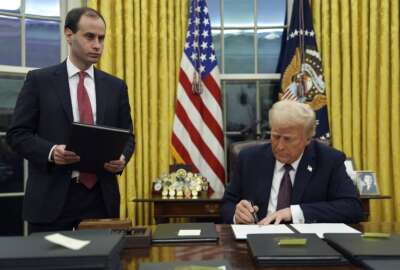DHS’ slow progress in centralizing acquisition frustrates Congress
Members of Congress are frustrated at what they see as a failure by the Department of Homeland Security to effectively manage the acquisition practices of its...
wfedstaff | April 17, 2015 5:33 pm
In 2008, Customs and Border Protection began a project to modernize its UH-60 helicopters, a fleet of aging rotorcraft it mostly borrows as excess hand-me-downs from the Army. It converted two of those rotorcraft in four years at a cost of more than $22 million each — roughly the same amount it would take to buy a brand new UH-60 Blackhawk fresh from the assembly line.
The Coast Guard, which operates an extremely similar airframe, overhauled 27 helicopters during the same time period at less than a quarter of the rate CBP paid. But the two DHS components never coordinated their efforts.
And in an audit released last month, the department’s inspector general found that while some components were facing shortages and breakdowns of radio equipment and requesting additional funding to modernize their communications systems, other offices within DHS were storing thousands of unused radios in warehouses, partially because equipment inventories aren’t reliably tracked across the agency.
Congressional and outside overseers view those examples as symptomatic of a federal department that’s still struggling, 12 years after its creation, to centralize and harmonize its oversight and management of acquisition programs and policy.
But they also acknowledged that DHS has come a long way since it absorbed 22 separate agencies a dozen years ago. And department officials say they’ve been busily implementing best practices from industry.
Rafael Borras, the undersecretary for management who doubles as the chief acquisition officer, said the department does have a formal, centralized acquisition management structure, including the two-year-old Office of Program Accountability and Risk Management (PARM).
“We have enhanced oversight,” he said. “It’s resulted in 136 acquisition review boards, which have resulted in 250 specific decision memorandums that result in specific actions that the components and the programs must take in order to proceed. We’ve canceled three major programs and we’ve paused eight. We’ve ordered a change in leadership in many programs as well.”
Acquisition planning shortcomings
The Government Accountability Office and the department’s IG say DHS has indeed checked all the right boxes when it comes to creating policies on management and oversight. But consistent implementation and execution is another matter.
Michele Mackin, the director for acquisition at sourcing management at GAO, said all too often, major acquisition projects are missing important features at their outset such as an approved acquisition baseline.
“That baseline represents the program manager’s agreement with the department about the cost, schedule and performance parameters of a program. It’s important, because it allows DHS and Congress to track progress and hold program managers accountable for outcomes,” she said. “But last year, only about a third of 63 major programs had approved acquisition baselines. This situation doesn’t put the department in a good situation to manage its acquisitions, and it complicates efforts to track cost and schedule growth.”
GAO found in a 2012 report that 16 of the department’s major programs had a collective 166 percent cost increase over three years. The overall tab for those cost growths totaled $30 billion.
“Perhaps more important was that we couldn’t make those kinds of assessments of many other programs, because the underlying data wasn’t valid,” Mackin said.
Auditors also have found cases in which acquisition policy directives from headquarters appear to have been circumvented or ignored.
For instance, in the case of the helicopter modernization, the department’s chief procurement officer warned CBP’s Air and Marine office in March 2008 that it needed to come up with more definitive cost estimates, define a period of performance, analyze other alternatives and run its plans through DHS’ nascent centralized acquisition review process.
But CBP moved ahead with the project anyway, signing a contract with the Army to perform the work just a few days later, auditors found.
“We’ve had our challenges with the Office of Air and Marine,” Borras said. “Part of the issue is that it’s never been organized into a comprehensive procurement program in the way that, for example, the Coast Guard has, where there’s a complete program for the identification of requirements. It’s a very fractured, unorganized program.”
Ending “rogue” contracting
In response, Borras said he has directed CBP to bring all of its air and marine acquisition programs before DHS’ central acquisition review process and bring its projects in line with department policy.
“They have not in the past done that. That is a fact, and I acknowledge that. We have now told them they will not proceed with any acquisitions at all until that’s done,” he said.
To prevent future instances of what one lawmaker called “rogue” behavior by subordinate-level DHS agencies, Borras said the department also is installing its own acquisition executives in every DHS component.
“The oversight of acquisition can’t be done just by headquarters. We don’t have the personnel to handle 90,000 transactions every year,” he said. “So these individuals are assigned by me personally, they now sit in the components, and they are our eyes and ears. It’s their job to perform oversight. It’s in their performance plans, and they’re responsible for it.”
Borras testified at a House Homeland Security Committee hearing Thursday designed to examine lessons learned by the private sector and the Defense Department that DHS could incorporate into its own activities.
He said the department is eager to embrace lessons from other entities, but he argued it’s a bad idea to compare DHS to any one department, since Congress doesn’t oversee it or fund it like a single department, especially when it comes to procurement.
“DoD, by and large, has unified procurement accounts, and they’re pretty much the same across the board,” Borras said. “We don’t have that in DHS. It would be of great value to us, because some of our procurement money is in salaried expense accounts, some of it is in [operating and maintenance] accounts, some of it is other places. We’ve asked Congress for it before, but we still don’t have a central repository for DHS procurement funds. And in the absence of good financial management systems, it’s very, very difficult.”
RELATED STORIES:
DHS, DoD strive for new strategy: be smarter with less
DHS aims to change history of lax acquisition oversight
Management successes paving the way for One- DHS
Copyright © 2025 Federal News Network. All rights reserved. This website is not intended for users located within the European Economic Area.
Jared Serbu is deputy editor of Federal News Network and reports on the Defense Department’s contracting, legislative, workforce and IT issues.
Follow @jserbuWFED






